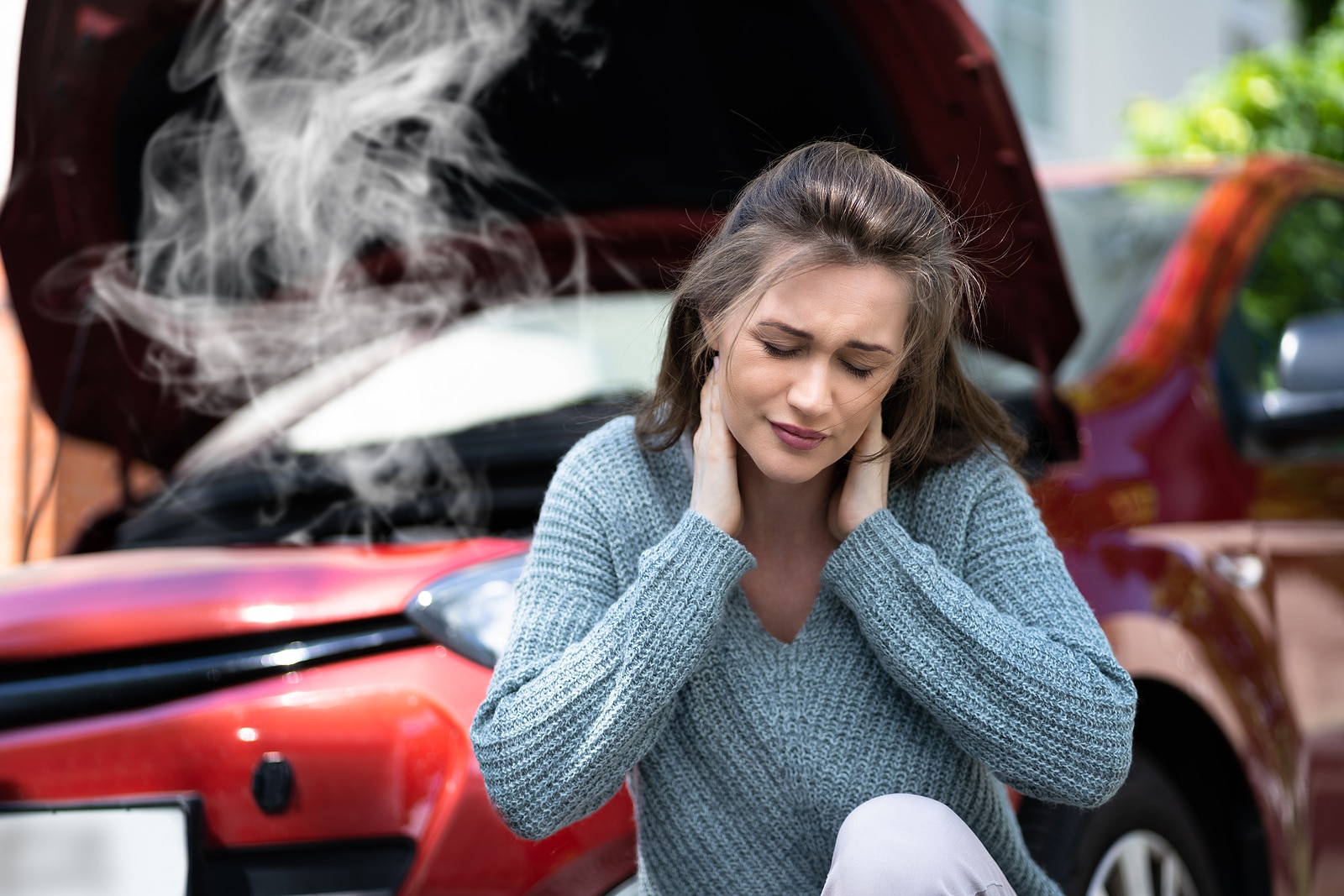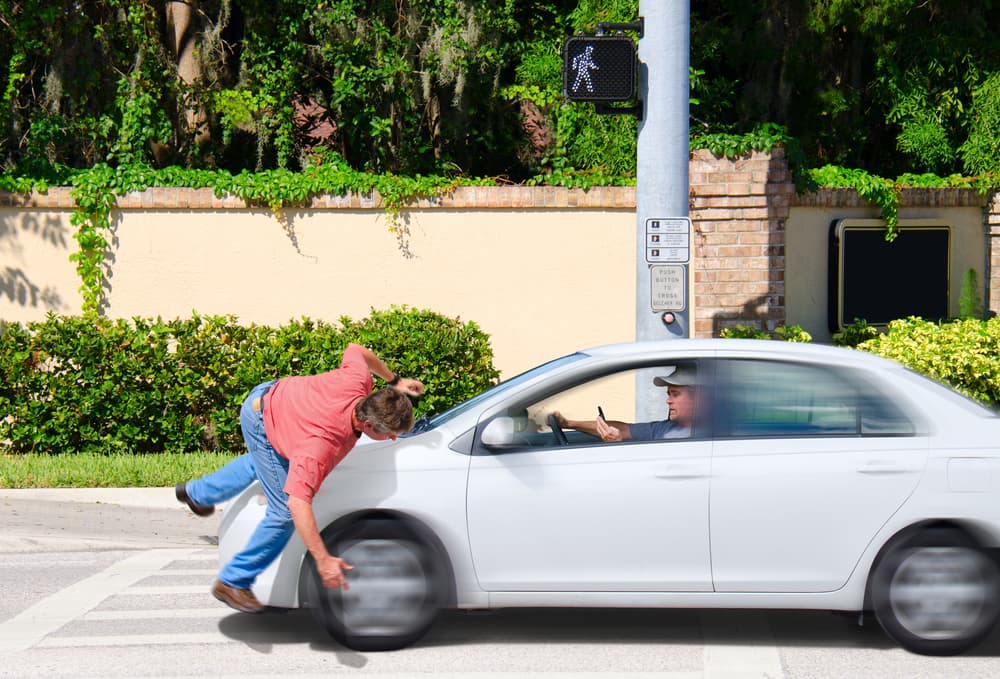Our bodies absorb the energy created and disbursed in a car crash. The human musculoskeletal system is fragile, and there is a limit to the amount of stress and trauma it can stand without significant and long-lasting damage.
The dynamics of an accident can be extremely frightening. As the car begins to crumble, the accident may subject passengers to a barrage of flying metal and glass and subjects the body’s tissues, bones, and organs to catastrophic injury.
This may sound strange for someone without any first-hand knowledge of motor vehicle accidents—immediately following the impact, typically, the body will experience a rush of the natural hormone, adrenaline.
In times of stress, the release of adrenaline is a self-preservation response to a traumatic event.
So while a car accident may toss the passengers from right to left, thrust them into the dash, smash them against the windshield, bombard them with flying objects, or ejected them from the vehicle, in a brief amount of time:
- Breathing becomes more rapid
- Dilated blood vessels increase the flow of oxygen to the muscles
- Energy and strength increase
- Vision and hearing become singularity focused
- Increased awareness
- There is a diminished sensation of pain
The adrenaline places the body on high alert to call upon all its resources. Simultaneously, the body releases the neurotransmitter endorphin, which acts as a natural painkiller.
Brace for Impact
Drivers who can spot an accident in the making may instinctively brace for impact. Scientific knowledge evolves, but the basics remain the same— bodies in a car are, in fact traveling at the same speed as the vehicle. There is some validity to the theory that pressing the back and head against the car seat and headrest while firmly depressing the brake may lessen the severity of the injury.
Possible Injuries Resulting From a Car Accident
Based on the size of the motor vehicles, their weight, and the speed each is traveling, injuries may include:
 Head injuries
Head injuries- Spinal cord or neck injury
- Injury to both upper and lower extremities
- Burns
- Traumatic amputation
- Organ damage
- Severe blood loss
- Fractures
- Crush injury
Motor vehicle crashes are a leading cause of trauma-related death in the U.S. each year, according to the National Highway Traffic Safety Administration.
The Consequences of Common Car Accident Injuries
Head injuries
A brain injury can cause wide-ranging physical and psychological symptoms such as:
- Headache
- Nausea
- Vomiting
- Extreme fatigue
- Speech disturbances
- Dizziness
- Loss of balance
- Sensitivity to light
- Insomnia
- Depression
- Anxiety
- The inability to concentrate
- Personality changes
- Loss of memory
- Blurred vision
Spinal cord or neck injury
Damage to the spinal cord can leave an accident victim with a loss of sensation below the level of injury—and a lifetime confined to a wheelchair.
Injury to both upper and lower extremities
Besides painful breaks of the long bones in the arms and legs, an accident victim may experience a pelvic fracture or dislocation of the shoulder, hip, or elbow. Damage to the arms and legs is common in a car accident, especially if the passenger tries to brace for impact. These are not simple injuries and may result in permanent disfigurement, as well as nerve and muscle damage.
Soft tissue injury
Soft tissue injury causes localized and radiating pain.
Sprains and strains can result in a victim experiencing:
- Pain
- Bruising
- Loss of flexibility
- inflammation
- Tenderness
- Muscle spasms
Lacerations are a type of soft tissue injury that, if not treated promptly, can lead to infection and permanent scarring. Another type of soft tissue injury is shoulder impingement. This can happen when the airbag slams into the upper torso, and it will cause pain and a limited range of motion.
A torn ACL (anterior cruciate ligament) is also common in a car accident. Knee injuries may come in rollover and rear-end collisions when the passenger has a sudden and violent change in the direction of their body. This is also true in an MCL (medial collateral ligament) tear, which can cause knee pain and instability when walking.
Nerve damage
Severe trauma from a car accident can result in temporary or permanent nerve damage.
Symptoms include:
- Difficulty speaking
- Arms or legs falling asleep
- Tingling sensation
- Abnormal pain and sensitivity
- Paralysis
- Dizziness or lightheadedness
- Loss of muscle strength
Burns
When the skin comes in contact with hot metal, steaming surfaces, acidic fluids, or open flames, a passenger in a motor vehicle accident may suffer deep tissue burns. The treatment is painful and can leave permanent scars. Additionally, burn victims are prone to infection and septic shock.
Traumatic amputation
When sharp metal car parts and glass shards become airborne in a collision, you can lose your fingers and toes. Crush injuries may eventually lead to the need for surgical amputation of an arm or leg.
Organ damage
High-impact crashes can cause damage to the abdomen, spleen, pancreas, liver, kidneys, heart, and intestines. These injuries can result in serious complications or death if not treated immediately. A cardiac contusion can permanently damage the heart tissue and lead to a heart attack. Renal trauma may lead to kidney damage, a ruptured spleen can cause life-threatening bleeding, sometimes days or weeks after a motor vehicle accident.
Severe blood loss
High-speed collisions can result in powerful external blows to the body, causing serious damage to internal tissues and massive blood loss. Massive blood loss makes it difficult for the heart to pump blood to vital organs, and the body can experience hemorrhagic shock.
Not All Injuries Appear at First
Some injuries take days, or possibly even weeks, to present symptoms. A delayed physical reaction to a traumatic event could signify an undiagnosed and serious ailment.
Do not ignore:
- Swelling
- Problems concentrating
- Audio impairment
- Visual problems
- Headaches
- Dizziness
- Confusion
- Mood swings
- Increased anxiety
- Unexpected pain, or pain that worsens with movement
- Sleep pattern changes
- Slow response time
- Nausea
- Blood in the urine
- Memory loss
- Depression
- Slurred speech
Many people experience emotional upheaval after a catastrophic accident. If left untreated, psychological symptoms can develop into post-traumatic stress disorder.
Injuries Based on Positions of Passengers
Where and how a passenger sits in an accident can make a difference in the physical damages. Every person in the car may sustain entirely different injuries.
For example, a seatbelt is less effective if the seat is in a reclined position. In this case, there could be more room between the chest wall and the restraint, allowing a body to slip underneath the belt.
A vehicle’s safety features (airbags and seatbelts) are most effective when people sit upright and look straight ahead. Leaning back (even slightly) or turning the head to look right or left can lead to more severe head and neck injuries. Shifting one’s weight or leaning from side to side can cause hip and pelvic damage.
Age is also a factor when it comes to accidents. Young children and the elderly may potentially sustain more severe bodily damage. Those sitting next to a window may receive more facial lacerations than those sitting in a middle seat. Front seat passengers will likely suffer airbag burns. When the airbag deploys, serious leg and ankle fractures are probable for riders with their feet up on the dashboard.
Different Car Accidents Cause Different Injuries
Even at low speeds, when two vehicles collide, usually at the very least passengers can expect:
- Whiplash
- Bruising
- Facial lacerations
- Back and neck pain
Head-on collisions
Head-on crashes are potentially more severe than other types of collisions and frequently more deadly. When two vehicles move toward each other, the impact force can cause traumatic head and brain injury, spinal cord damage, severe internal organ damage, and crush-type injury.
Runoff the road accidents
Roadway departure accidents may well be one of the most deadly. When a single vehicle veers off the roadway and collides with a fixed object ( tree, telephone poll, highway divider barrier, etc.), head, neck, and spinal injuries can be expected.
Rollover accidents
Rollover accidents have a high fatality rate.
This accident primarily causes damage to:
- The head
- The neck
- The chest wall
- Upper and lower extremities
Rear-end accident
A rear-end accident is one of the most common automobile accidents, with injuries ranging from mild to severe. Head injury, and back injury, on the other hand, can be life-changing.
Sideswipe accidents
When two vehicles are traveling side by side, and one strikes the side of the other, the struck vehicle will often veer out of its travel lane. Whether they hit another car or a fixed object, common injuries include whiplash, broken bones, internal organ damage, spinal cord damage, head injuries, and traumatic brain injuries.
T bone accidents
Although some cars have side curtain airbags, most T-bone crashes leave passengers unprotected. Why? Because the sides of a car do not have as much mass as the front or rear. It is all about physics. Extremely lucky people can walk away from a side-impact collision. Passengers closest to the point of impact are prone to traumatic brain injury, severe fractures, spinal damage, and death.
Full Recovery After a Car Accident Can Take Time
It can take months, possibly even years, to fully recover from the physical damage sustained in a car accident. Victims often need extensive physical therapy to recover muscle function and the full range of motion for daily activities.
Those who suffer permanent injury may need the help of an occupational therapist to learn new techniques for doing things they can no longer do. Behavioral therapists may be able to help accident victims deal with the devastating and debilitating effects of the emotional trauma they are likely to experience.
Factors That Affect a Bodily Injury
Age, and pre-existing medical conditions, combined with the particulars of the incident, directly impact the severity and consequences of a motor vehicle accident.

According to the Centers For Disease Control (CDC), young people between 16 and 19 are three times as likely as those over 20 to die in a car crash. According to an article in Forbes, “A child is involved in a crash while riding in a passenger vehicle, on average, every 25 seconds.”
Improperly installed child safety seats are part of the problem. Catastrophic car accidents can exacerbate some medical conditions. Passengers with a history of degenerative back and neck issues and those with arthritis may suffer worse injuries than a passenger with no known orthopedic issues. Passengers with cardiac problems are more likely to suffer a heart attack or a stroke following a car accident.
In times of stress, a diabetic’s blood glucose levels can rise or fall to dangerous levels. Folks recovering from a serious illness, or undergoing medical cancer treatments, are likely to experience a setback.
No matter how minor the accident, how strong and sturdy the vehicle is, and despite seatbelts, passengers involved in a car crash are likely to have potentially serious injuries. Contact a New Richey car accident lawyer near you for a no-cost consultation. With that help, you and your family may pursue financial compensation for injuries and losses.



